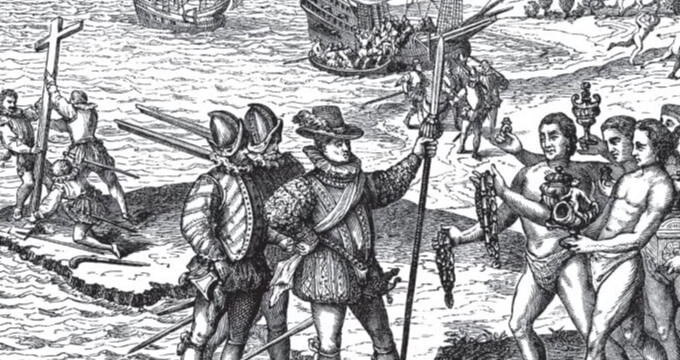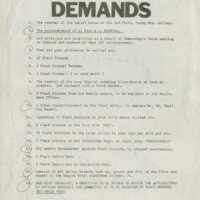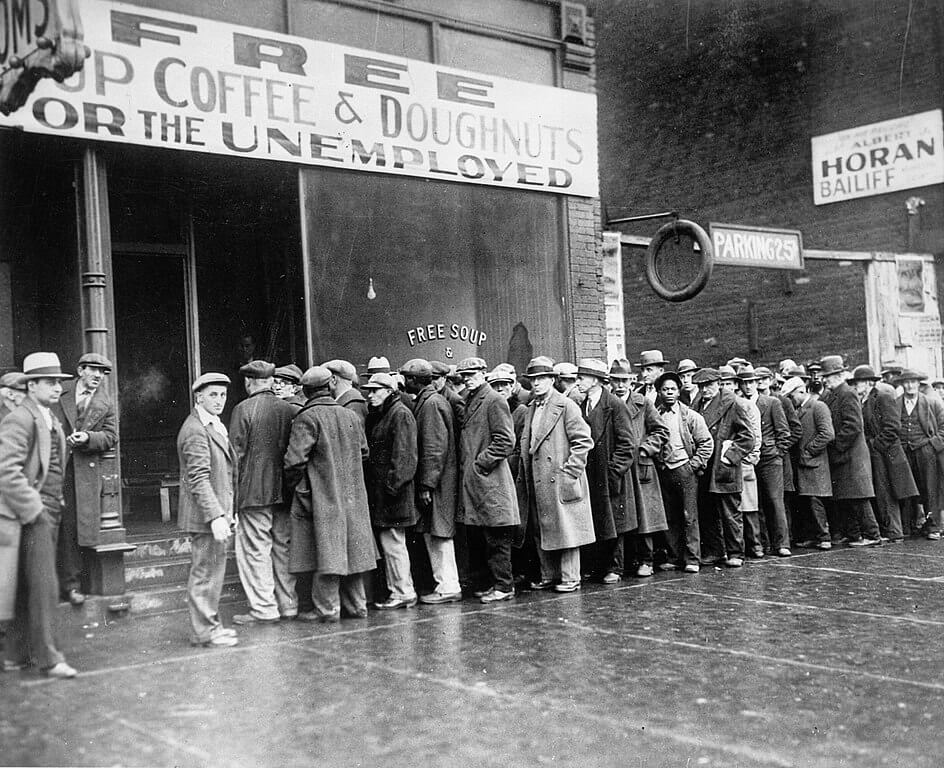Teaching Labor’s Story
Teaching Labor's Story
Teaching Labor’s Story is a repository of primary sources with supporting teaching guides (textual, visual, audio). Resources in the Teaching Labor’s Story repository are designed to be readily incorporated into the existing curriculum and thus allow experts and non-experts alike to re-infuse labor’s story into the historical narrative. Each primary source is linked to one of ten commonly taught eras in American/United States history. TLS sources are selected to reveal significant perspectives on essential historical questions, and each source is accompanied by a guide that includes an informative contextualizing essay, glossary, discussion questions, curricular connections, and additional sources.
Organization
The repository is divided into ten historical eras, aligned with commonly used chronological divisions in American/U.S. history texts and courses. Click on a Historical Era to discover primary sources that tell labor’s story during that historical era.
Content of Each Entry
Each entry begins with a very brief headnote, followed by the Primary Source. Primary Sources are no longer than two pages; sources longer than two pages are carefully excerpted to retain the content and meaning of the full source. All sources are original text (not simplified or reworded).
There is a linked Teaching Guide for each primary source. The teaching guides, written by professional historians, explain who created or wrote the primary source and the intended audience (sourcing the source); how the primary source is connected to major themes in the historical era (historical context); what to look for in a close reading of the primary source (meaning and significance of the primary source); definitions of potentially unfamiliar words (glossary); discussion questions; additional resources; connections to curricular standards.
Additional Features
A separate glossary of terms and thematic tags offer additional ways to access these resources.
Scholarly Quality
Each TLS entry is written by a professional historian. All entries pass a double-blind peer review before publication.
Teaching Blog
New Teaching Labor’s Story: Detroit Revolutionary Union Movement, 1969
- November 27, 2023
New Teaching Labor’s Story Unit: The Soup Song from the 1930s
- August 17, 2022
2 New Teaching Labor’s Story Units: Women’s Rights are Labor Rights
- February 23, 2022
Four New Teaching Labor’s Stories! Check them out —
- February 19, 2021
Teaching Labor’s Story is a repository of primary sources with supporting teaching guides (textual, visual, audio). Resources in the Teaching Labor’s Story repository are designed to be readily incorporated into the existing curriculum and thus allow experts and non-experts alike to re-infuse labor’s story into the historical narrative. Each primary source is linked to one of ten commonly taught eras in American/United States history. TLS sources are selected to reveal significant perspectives on essential historical questions, and each source is accompanied by a guide that includes an informative contextualizing essay, glossary, discussion questions, curricular connections, and additional sources.
Historical Eras

Era 1: Three Worlds Meet (Beginnings to 1620)
Lorem ipsum dolor sit amet, consectetur adipiscing elit, sed do eiusmod tempor incididunt ut labore et dolore magna aliqua

Era 2: Colonization and Settlement (1585-1763)
Lorem ipsum dolor sit amet, consectetur adipiscing elit, sed do eiusmod tempor incididunt ut labore et dolore magna aliqua

Era 3: Revolution and the New Nation (1754-1820s)
Lorem ipsum dolor sit amet, consectetur adipiscing elit, sed do eiusmod tempor incididunt ut labore et dolore magna aliqua

Era 4: Expansion and Reform
Lorem ipsum dolor sit amet, consectetur adipiscing elit, sed do eiusmod tempor incididunt ut labore et dolore magna aliqua

Era 5: Civil War and Reconstruction (1850-1877)
Lorem ipsum dolor sit amet, consectetur adipiscing elit, sed do eiusmod tempor incididunt ut labore et dolore magna aliqua

Era 6: Development of the Industrial United States (1870-1900)
Lorem ipsum dolor sit amet, consectetur adipiscing elit, sed do eiusmod tempor incididunt ut labore et dolore magna aliqua

Era 7: Emergence of Modern America (1890-1930)
Lorem ipsum dolor sit amet, consectetur adipiscing elit, sed do eiusmod tempor incididunt ut labore et dolore magna aliqua

Era 8: Great Depressino and World War II (1929-1945)
Lorem ipsum dolor sit amet, consectetur adipiscing elit, sed do eiusmod tempor incididunt ut labore et dolore magna aliqua

Era 9: Post-War United States (1945-early 1970s)
Lorem ipsum dolor sit amet, consectetur adipiscing elit, sed do eiusmod tempor incididunt ut labore et dolore magna aliqua

Era 10: Contemporary United States (1968-present)
Lorem ipsum dolor sit amet, consectetur adipiscing elit, sed do eiusmod tempor incididunt ut labore et dolore magna aliqua
Historical Eras
- Era 1: Three Worlds Meet (Beginnings to 1620)
- Era 2: Colonization and Settlement (1585-1763)
- Era 3: Revolution and the New Nation (1754-1820s)
- 3.1 Account of the Grand Federal Procession, 1788 *An excerpt from a longer pamphlet describing the “Grand Federal Procession” of 1788, which celebrated the very recent ratification of the U.S. Constitution.
- Era 4: Expansion and Reform (1801-1861)
- Era 5: Civil War and Reconstruction (1850-1877)
- Era 6: The Development of the Industrial United States (1870-1900)
- Era 7: The Emergence of Modern America (1890-1930)
- 7.1 Destitution in West Virginia, Commission Report, 1922 *An excerpt from a longer report describing living and working conditions of miners in West Virginia in 1922.
- 7.2 Margaret Haley, “Why Teachers Should Organize” 1904 *An excerpted speech given by teacher union leader Margaret Haley to the general assembly of the National Education Association in 1904. It was also published in the Journal of Education.
- 7.3 Clara Lemlich, “The Inside Story of a Shirtwaist Factory” 1912 *Clara Lemlich, an immigrant garment worker and labor leader, describes the dangerous and dehumanizing working conditions in New York City’s garment industry and makes a case for woman suffrage.
- 7.4 Margaret Chanler Aldrich, “The Week Before Christmas,” December 20, 1911 *This poem describes conditions faced by retail workers during the Christmas holiday season in the early 1900s. It is critical of wealthy shoppers who contribute to workers’ misery, and was used by the National Consumers’ League to encourage consumers to be allies by getting their shopping done early.
- 7.5 Lady Vaudeville and Her White Rats, 1909. *Excerpt from George Fuller Golden’s 1909 memoir about his career as a Vaudeville artist and labor organizer.
- 7.6 Right of Women To Vote – Kate Debs *In an article from the Appeal to Reason newspaper, Kate Metzel Debs, wife of five-time Socialist presidential candidate Eugene V. Debs, presents arguments for the right of women to vote, especially working women.
- Era 8: The Great Depression and World War II (1929-1945)
- 8.1 UAW-CIO song, 1942. *This song is about the struggles by auto workers to organize a union and their patriotic pride as both producers for and soldiers in the American war effort during World War II. It equates unionism with patriotism.
- 8.2 Blank Pay Days, 1933 *This document is excerpted from an article written by a Chicago school teacher about how the Great Depression was affecting her work and personal life; published 1933 in The Saturday Evening Post.
- 8.3 Spasmodic Diary of a Chicago School Teacher, 1933 *An excerpt from a published selection of a diary that belonged to an anonymous Chicago public school teacher, which was published in The Atlantic Monthly in November 1933.
- 8.4 Memorial Day Massacre, 1937 *An eyewitness narration of unedited newsreel footage of the 1937 Memorial Day Massacre in Chicago, Illinois when steel unionists and their supporters were met with police violence on their way to demand the right to set up a mass picket in front of Republic Steel.
- 8.5 Murder of Frank Hanes, 1939. *These three letters describe the murder of an African American farm worker named Frank Hanes by Mississippi plantation owner Tom Alexander. Bernice Wims wrote to the U.S. attorney general to request an investigation, but the federal government refused to act.
- 8.6 Charles Houston, Scottsboro Case, Revisited, 1939. *Charles Houston delivered this speech to an International Labor Defense conference on July 8th, 1939. His “Special Paper on…Educational Equality” speech draws a connection between labor, civil rights, and education. Houston specifically links the Scottsboro Case to labor control.
- 8-7-The-Soup-Song-1930“The Soup Song” uses humor and sarcasm to convey workers’ experiences and attitudes during the Great Depression. As a widely popular participatory song, it was an effective tool for labor organizing.
- Era 9: Postwar United States (1945 to early 1970s)
- 9.1 Triumph of the Paraprofessionals, August 22, 1970 *This opinion piece by civil rights organizer Bayard Rustin celebrates the signing of the first union contract for paraprofessional educators — community-based classroom and school support staff, nearly all of them black and Hispanic women — in New York City. It was published in the New York Amsterdam News, the city’s largest black-owned newspaper, in 1970.
- 9.2 Chavez Explains the Need for Boycotts, 1972 *A TV interview with United Farm Workers leader Cesar Chavez conducted at the height of the struggle during the 1972 election season.
- 9.3 NOW, Statement of Purpose, 1966 This Statement of Purpose, a founding document of the National Organization for Women (NOW), outlined the founders’ explanation of the problems facing American women and asserted that their sex should organize to solve them. As the largest feminist membership group of the “second wave” era, NOW attacked many of the gendered inequalities that defined American life—especially those related to work
- Era 10: Contemporary United States (1968 to the present)



